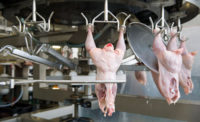Two new videos in the Meat MythCrushers series—produced by the North American Meat Institute (NAMI) and American Meat Science Association—are tackling what producers say are long held myths about worker safety and how line speeds are regulated in the meat and poultry industry.
Featuring Dennis Burson, professor meat extension and food safety specialist at the University of Nebraska, the videos discuss improvements in the industry that have led to considerable worker safety benefits. Department of Labor statistics show meat and poultry industry injury and illness rates are at an all-time industry low of 5.5 cases per 100 full-time workers per year in 2014. The results demonstrate a substantial improvement from 10 years ago, when the number of injuries and illnesses stood at 10.3 cases per 100 full-time workers.
Burson says a significant driver of worker safety improvement can be attributed to the creation of Voluntary Ergonomic Guidelines for the Meat Packing Industry developed in 1990 with OSHA and the United Food and Commercial Workers union.
The video also details the variety of tools workers use in meat and poultry plants to help ensure their safety.
In the second video clarifies how line speeds in meat plants are regulated, noting that USDA Food Safety and Inspection Service inspectors determine maximum line speeds and can slow down processing lines if there are food safety, worker safety or animal welfare concerns.
The newest videos are the 48th and 49th in the six-year-old series featuring interviews with meat scientists who bust some of the most common myths surrounding meat and poultry production and processing. Other video topics include meat nutrition, antibiotic use in livestock, “Superbugs” in meat, hormone use in animals, ammonia in ground beef, and grass-fed beef among others.





